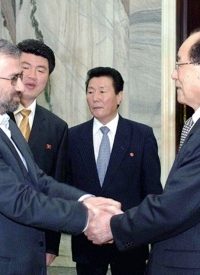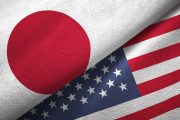
As government representatives from the United States, South Korea, and Japan announce that they will meet in Washington, D.C., in early December to discuss North Korea following its attack on South Korea, the recent WikiLeaks release of classified U.S. diplomatic cables has shed new information on the world’s sole remaining Stalinist state.
The first batch of cables released on Sunday of “Secret American intelligence assessments” revealed that “Iran has obtained a cache of advanced missiles, based on a Russian design, that are much more powerful than anything Washington has publicly conceded that Tehran has in its arsenal,” (emphasis added) according to the New York Times.
These Russian missiles, described as perhaps being “based on a Russian design called the R-27, once used aboard Soviet submarines to carry nuclear warheads,” were obtained “from North Korea, according to a cable dated Feb. 24 of this year,” stated the Times.
Although the cables confirm the total number of missiles obtained as 19, the missiles nevertheless provide Iran with a projectile guidance system capable of reaching the capital cities of Western Europe, leaving no part on the continent safe from a hypothetical attack.
Despite already-imposed U.N. sanctions, the fact that North Korea has sold these nineteen R-27-like missiles demonstrates just how ineffective the United Nations has been in dealing with and containing Pyongyang.
This is not the first recorded incident of North Korea selling weapons to Iran.
On December 12, 2009, Reuters reported that Thai officials “seized more than 35 tons of arms from a cargo plane they said had come from North Korea,” following an emergency landing at Don Muang Airport in Bangkok.
The following day Reuters cited the crew manifest’s listing that the aircraft was staffed by “five crew members — four from Kazakhstan and one from Belarus.”
A week later, the Wall Street Journal reported that according to “documents obtained by arms-trafficking experts” that the now-described Ilyushin-76 cargo plane “loaded with weapons from North Korea that was recently impounded in Bangkok was bound for Iran.”
Iran’s ambition for weapons of mass destruction is nothing new, but news of North Korea being the arms supplier is revealing, as it demonstrates that even after the Cold War and the purported fall of Communism in the Soviet Union, North Korea still remains a key Communist exporter of weapons and international terrorism.
Since at least the early 1970s, North Korea has acted as a Soviet surrogate for international terrorism, training an array of terrorist criminals, from the infamous Mexican drug lord Amado Carrillo Funetes and his band of guerillas to Dr. George Habash and his Popular Front for the Liberation of Palestine.
The news of these missile purchases to the terrorist-sponsoring state of Iran reveals that North Korea still maintains the traditional Marxist-Leninist policy of supporting terrorism, which continues to be the policy behind terrorism today, as reported by journalists William F. Jasper and Thomas R. Eddlem in The New American magazine.
North Korea’s arms-sale relationship with Iran is believed to be longstanding, at least according to Bruce Klingner, an analyst at the Heritage Foundation in Washington and former chief of the Central Intelligence Agency’s Korea branch, who said that “North Korea and Iran have had a decades-long missile relationship and also most likely a nuclear relationship.”
Ambassador Seyed Mahmoud Reza Sajjadi, the Iranian Ambassador to Russia, replied to reporters in Moscow, when asked about the WikiLeaks story: “Given Iran’s military potential, we don’t require such deliveries from North Korea.”
Whether or not Iran may require such armaments shipments today is another thing, but one thing that is certain, at least according to the leaked classified cables, is that Iran has already received “such deliveries from North Korea.”
If Iran does not need these weapons, as Ambassador Sayed stated, then why did it purchase them? For what purpose does Iran intend to use these 19 missiles? Unfortunately the answer to that still remains unknown and uncertain.
Another thing that is uncertain is the United States’ and South Korea’s contingency plan for when and if the Communist regime in Pyongyang collapses.
On Monday, November 29, 2010, the New York Times reported that “American and South Korean officials early this year secretly began gaming out what would happen if the North, led by one of the world’s most brutal family dynasties, collapsed,” based on the latest WikiLeaks diplomatic cable exposé.
The leaked cables also reveal South Korea’s concern and dissatisfaction over China for its perceived satisfaction and support of “the status quo of a nuclear North Korea,” due to China’s fears “that a collapse would unleash a flood of North Korean refugees over the Chinese border and lead to the loss of a ‘buffer zone’ between China and the American forces in South Korea,” as reported by the Times.
The South Korean belief that China sees North Korea as a “buffer zone” would suggest that Seoul still views the division in the East as being between the Communist and non-Communist world, thus presenting China in an unflattering light.
In a secretive lunch meeting with the U.S. Ambassador to South Korea, Kathleen Stephens, in February of 2010 Chun Yung-woo, the Vice-Foreign Minister of South Korea, predicted that the Pyongyang regime would collapse “two to three years” after the death North Korea’s currently ailing dictator Kim Jong-il.
By such time, Chun Yung-woo believes that the next generation of Chinese leaders “would be comfortable with a reunited Korea controlled by Seoul and anchored to the United States in a benign alliance.”
Despite China’s current comfort with having a nuclear-armed North Korea as buffer between China and South Korea, the cables revealed that a “Chinese ambassador warned that North Korean nuclear activity was ‘a threat to the whole world’s security’,” according to the Guardian.
It was also revealed that Chun Yung-woo had been told by two senior Chinese officials that they, along with other leaders in Beijing, are of the belief that Korea should be reunified under the jurisdiction of Seoul, indicating that a possible shift in policy may be underway in Beijing.
Knowing China’s concern of a U.S.-backed united Korea, the cables also suggest that the United States might forgo any attempt to station U.S. military forces north of the Demilitarized Zone, as a means of allowing China to save face and win over their support.
With this option and Seoul’s belief that China favors it over Pyongyang having been revealed, China already knows what to expect from South Korea and the United States, such as its gesture not to mobilize U.S. forces north of the DMZ, and might decide to become more demanding through more favorable concessions if and when the scenario of a unified Seoul-governed Korea arises.
Only time will tell what the full repercussions will be of the divulgement of this information by WikiLeaks, but for now the Obama administration has made it clear that they are not pleased with the leakage of this information and are looking toward additional measures to assure the confidentiality of classified U.S. documents.
Photo (rotator image and above): Iranian Vice Foreign Minister Mohammad Ali Fathollahi, left, is welcomed by Kim Yong Nam, president of the Presidium of North Korea’s Supreme People’s Assembly, before a meeting in Pyongyang, North Korea, April 23, 2010: AP Images




